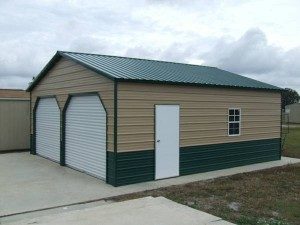There is absolutely nothing finer than a recommendation from one of our clients on a tool, process or procedure which they have used to make construction of their new Hansen Pole Building kit package easier.
A challenge, for many, is having to cut steel panels and trims with various sheet metal cutting tools often being inadequate or not available. After reading my article https://www.hansenpolebuildings.com/blog/2014/07/star-wars/ Michael Yamamoto (yes, I dole out credit where credit is due) passed along these words:
“Hi, here’s some feedback on your sheet metal cutting tool inquiry. I ended up using a “double cut” circular saw with two blades spinning in opposite directions. https://www.harborfreight.com/5-in-double-cut-saw-68316.html
It worked great. If I laid the panel upside-down (ribs downward) flat over some 2x4s while weighing down the panel next to the cut line, cutting across ribs was a breeze.”
Now this is not a tool I happen to own….at least not yet! But at $60, I’d be willing to give it a try.
Just like picking hotel rooms (sadly I live in them more than under my own roof – which is a story for another day), I read the product reviews and take them with a block of salt.
Given Michael’s feedback after use, I was surprised to see this product garner only a 2.7 out of 5 rating from reviewers. I did remind myself, most folks who are satisfied with a product, never take the time to leave a positive review – they are too busy happily using the product!
Easy to use got three votes to every one difficult to use, while fast cutting speed rocked for the reviewers (considering cutting steel with snips is very slow – this is a huge plus in my book).
The most liked negative reviewer stated:
“The basic concept of the saw is good, but the execution is flawed. When holding the saw with the right hand and the support handle with the left, the positioning is just awkward. The saw is too off balance with the handle placed too far from the main body. The on-off switch while similar to other brands, just feels cheap and prone to failure. Time will tell.
My BIGGEST gripe is the guarding seems poorly designed and dangerous. Normally with a circular saw, the saw is slid forward into the material, which pushes the guard open, allowing the material to be cut. This saws mounting clamp for the guarding is positioned below the opening or the guard. This means that when you press the saw into the material, it only goes a very short distance before it hangs up on the screw clamp for the guard. To continue further, either the saw must be rotated back over the clamp or the saw must be lifted partially out of the material being cut. The only way to really use this saw is to manually open the guard all the way, then start the saw and plunge into the material. This is EXTREMELY dangerous. Examining the guard, the solution would be to rotate the clamp out of the way and re-tighten. The clamp is part of the housing and can’t be rotated.
While I have the ability to make a new handle mount and rework the guard mount to make this saw safe to use, I wouldn’t recommend this saw to the casual user. There is too much potential for injury due to the guarding design. For those users, I would recommend getting a name brand saw. For experienced users who are aware of proper safety procedures, this is a handy tool when used with caution.”
As with any power tool – use it safely and sanely.
I will look forward to feedback from others who have used sheet metal cutting tools, or similar, on their pole buildings. And yes, next time I am in my favorite Home Depot, I will be heading to the tool department to check them out!
 Coaters Association, many installers have found the best way to make accurate, straight cuts in steel roofing and siding is to use a power saw.
Coaters Association, many installers have found the best way to make accurate, straight cuts in steel roofing and siding is to use a power saw.





